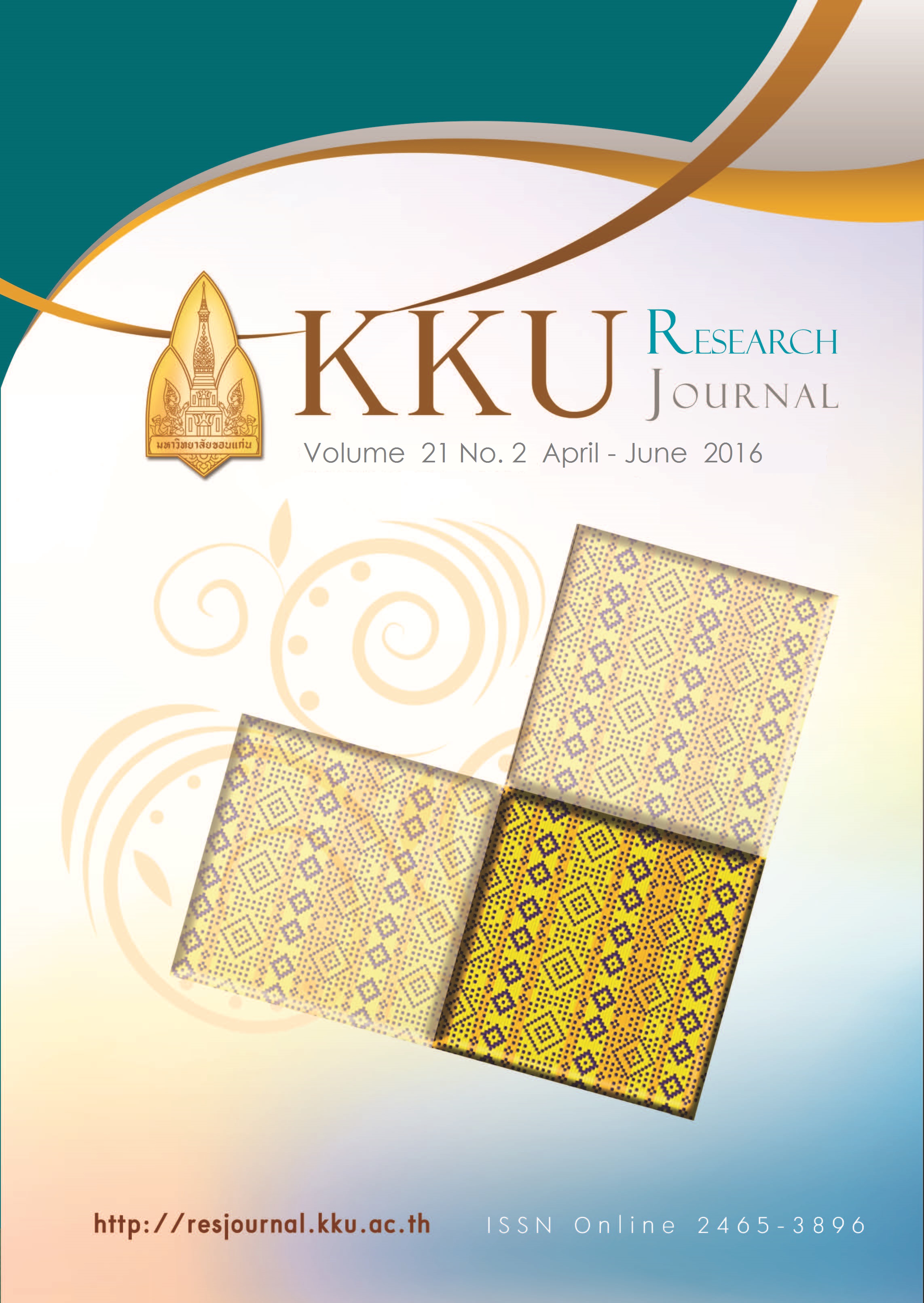Hydrogen production by immobilized cells of unicellular halotolerant cyanobacterium aphanothece halophytica in alginate beads
Main Article Content
Abstract
Hydrogen is an interesting alternative energy carrier that can be produced by various kinds of cyanobacteria. The unicellular halotolerant cyanobacterium Aphanothece halophytica is one of the potential cyanobacterial candidates for H2 production. Its dark fermentative H
2 production is catalyzed by bidirectional hydrogenase activity through the catabolism of storage glycogen. This work aimed to study H2 production by A. halophytica cells immobilized in alginate beads. The result showed that under nitrogen deprivation H2 production by the immobilized cells of A. halophytica in alginate cells was obviously higher than that of free cells. The highest H2 production was found in immobilized cells prepared from 4.5 % (w/v) sodium alginate in 100 mM calcium chloride. Finally, H2 production yield of 50 immobilized cell beads per 20 mL glass vial was higher than of 100 and 150 immobilized cell beads.
Article Details
References
[2] Benemann JR. Hydrogen production by microalgae. J Appl Phycol. 2000 Oct;12:291-300.
[3] Bothe H, Schmitz O, Yates MG, Newton WE. Nitrogen fixation and hydrogen metabolism in cyanobacteria. Microbiol Mol Biol Rev. 2010 Dec 1;74:529-51.
[4] Ananyev G, Carrieri D, Dismukes GC. Optimization of metabolic capacity and flux through environmental cues to maximize hydrogen production by the cyanobacterium“Arthrospira (Spirulina) maxima”. Appl Environ Microbiol. 2008 Aug 1;74:6102-13.
[5] Taikhao S, Junyapoon S, Incharoensakdi A, Phunpruch S. Factors affecting biohydrogen production by unicellular
halotolerant cyanobacterium Aphanothece halophytica. J Appl Phycol. 2013 25:575-85.
[6] Taikhao S, Incharoensakdi A, Phunpruch S. Dark fermentative hydrogen production by the unicellular halotolerant cyanobacterium Aphanothece
halophytica grown in seawater. J Appl Phycol. 2015 27:187-96.
[7] Bickerstaff GF. Impact of genetic technology on enzyme technology. Genet Engineeer Biotechnologist. 1995;15:13-30.
[8] Moreno GI. Microalgae immobilization: Current techniques and uses. Bioresour Tech. 2007 Jul 9;99:3949-64.
[9] Garlick S, Oren A, Padan E. Occurrence of facultative anoxygenic photosynthesis among filamentous and unicellular
cyanobacteria. J Bacteriol. 1997 Feb;29:623-9.
[10] Rao RS, Tripathi U, Ravishankar GA. Biotransformation of codeine to morphine in freely suspended cells and immobilized cultures of Spirulina platensis. World J Microbiol Biotechnol. 1999 Apr 15;15:465-9.
[11] MacKinney G. Absorption of light by chlorophyll solutions. J Biol Chem. 1941 Mar 13;140:315-22.
[12] Takabe T, Incharoensakdi A, Arakawa K, Yokota S. CO2 fixation rate and RuBisCO content increase in the halotolerant cyanobacterium, Aphanothece halophytica, grown in high salinities. Plant Physiol. 1998 Jun 29;88:1120-4. [13] Lawlor DW, Photosynthesis: molecular, physiological, and environmental processes. Scientific and Technical, Essex. 1993.
[14] Anjana K, Kaushik A. Enhanced hydrogen production by immobilized cyanobacterium Lyngbya
perelegans under varying anaerobic conditions. Biomass and Bioenergy. 2014 Feb 24; 63:54-7.
[15] Leino H, Kosourov SN, Saari L, Sivonen K, Tsygankov AA, Aro EM, Allahverdiyeva Y. Extended H2 photoproduction by N2-fixing cyanobacteria immobilized in thin alginate films. Int J Hydrogen
Energy. 2009 Sep 08;37:151-6.
[16] Kumar S, Subhashini CH T, Polasa H. Photoproduction of molecular hydrogen by an immobilized non-diazotrophic cyanobacterium Oscillatoria subbrevis strain 111. Proc. Indian natn. Sci. Acad. 1991;B57:89-94.


